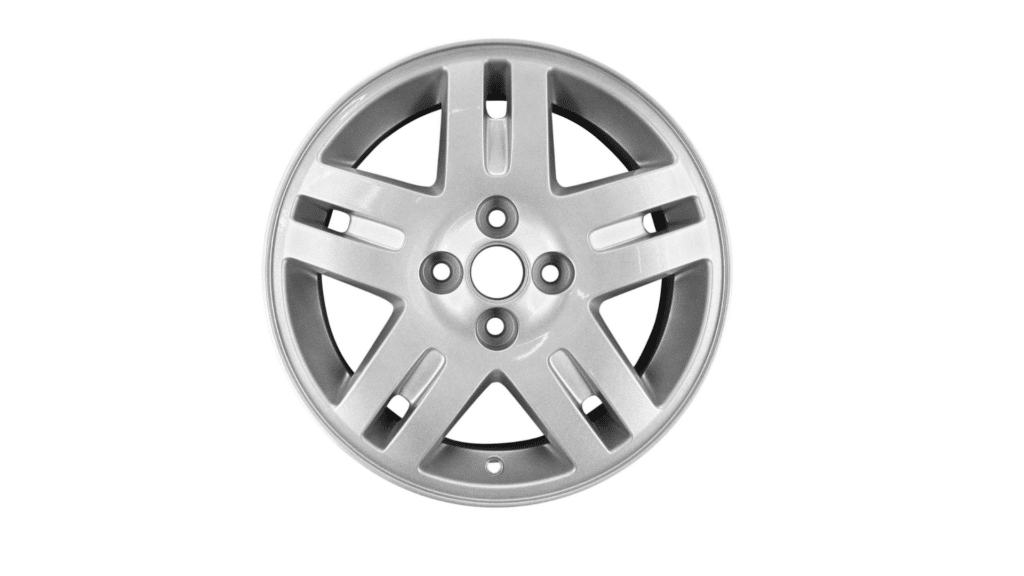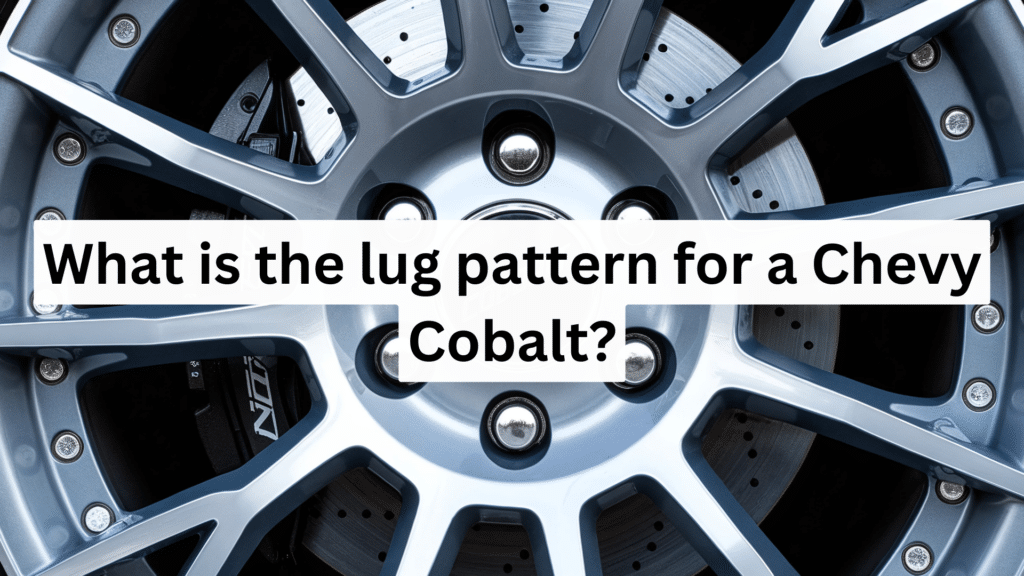Looking to figure out the lug pattern for your Chevy Cobalt? You’re in the right place.
I know how frustrating it can be when you’re trying to buy new wheels or replace your lug nuts, but you’re not 100% sure about the bolt pattern. In this guide, I’ll walk you through everything you need to know about your Cobalt’s lug configuration.
As a mechanic who’s worked on hundreds of Chevys, I can tell you that getting the right fit is crucial. Not only will you learn the exact lug pattern for all Cobalt model years, but I’ll also show you how to measure it yourself and what wheels are compatible.
The best part? No complex jargon or confusing terms. Just clear, simple information that’ll help you get the right wheels for your Cobalt the first time around.
Chevy Cobalt Lug Pattern Overview

I know how tricky it can be to find the right wheels for your Cobalt. Let me break it down for you.
The basics first: Your Chevy Cobalt uses a 5×110 lug pattern. That means it has 5 lugs in a circle, spaced 110 millimeters apart.
But wait – there’s something you should know.
Not all Cobalts are the same. The SS model sometimes came with different wheels. Check your owner’s manual to be sure.
Want to measure it yourself? Here’s how,
- Find the center of your wheel.
- Measure from the middle of one lug to the middle of the lug directly across.
- That’s your bolt circle diameter.
Here’s a cool fact: this 5×110 pattern is shared with other GM cars like the Saturn Ion and Pontiac G5.
Remember this: Always double-check your measurements before buying new wheels. A tiny difference can mean big problems.
Need to replace a lug nut? They’re M12x1.5 in size. Write that down – you’ll thank me later.
Bolt Pattern Details
Let me share the key details about your Cobalt’s bolt pattern.
First, what’s a bolt pattern? It’s how your wheel attaches to your car. Think of it like a fingerprint for your wheels.
Here’s what the numbers mean,
- 5 = Number of lugs
- 110 = Circle diameter in millimeters
- M12 = Bolt size
- 1.5 = Thread pitch
Do you have a tape measure? The circle diameter is about 4.3 inches. Super simple to check yourself.
A quick tip: Your Cobalt’s pattern matches several other cars. Saturn Ion, Pontiac G5, and some Saabs use the same setup.
But here’s something important: Always use the right torque. Too tight or too loose can cause big problems.
Want the magic number? Tighten those lug nuts to 100-foot pounds. That’s the sweet spot.
I’ve kept this straight and simple—no fancy stuff – just what you need to know about your Cobalt’s bolt pattern.
Wheel Fitment and Compatibility
1. Stock Sizes
- Your Cobalt’s original wheel sizes were 15-18 inches.
- Base models came with 15-16 inch wheels.
- Sport models rolled on 17-inch wheels.
- SS models rocked 18-inch performance wheels.
2. Safe Fitment Range
- Wheel diameter: 15-18 inches.
- Wheel width: 6-7.5 inches.
- Offset (ET): 40-45mm.
- Center bore: 65.1mm.
- Bolt pattern: 5x110mm.
3. Common Combinations
- Daily driving: 15×6.5 with 40mm offset.
- Better looks: 16×7 with 42mm offset.
- Sport handling: 17×7 with 45mm offset.
- Maximum performance (SS): 18×7.5 with 45mm offset.
4. Winter Setup
- Best size: 16×6.5 inches.
- Ideal offset: 40mm.
- Recommended width: Narrower for better snow performance.
- Steel wheels: Perfect for winter beater duty.
5. Spacer Info
- Maximum safe size: 25mm.
- Hub-centric required: Yes.
- Minimum quality: Grade 10.9 bolts.
- Regular inspection: Every 5,000 miles.
Remember: Always verify your specific model’s requirements. These specs fit most Cobalts, but some rare packages came with different setups.
Upgrading Wheels and Tires
1. Performance Options
- 17×7.5 inches: Best balance of looks and performance.
- 18×7.5 inches: Maximum grip and style. (SS-friendly)
- Summer tires: 225/45R17 or 225/40R18.
- All-season: 205/55R16 or 215/50R17.
- Plus-sizing: Stick to +1 or +2 for best results.
2. Budget Choices
- 16×7 inches: Perfect daily driver size.
- Steel wheels: Under $400 for a complete set.
- Used OEM: Often available under $300.
- Package deals: Wheels and tires from $800.
3. Fitment Tips
- Keep the offset between 40-45mm.
- Use hub-centric rings if needed.
- Stick with a 5×110 bolt pattern.
- Match tire width to wheel width.
4. Common Issues
- Wrong offset: Causes rubbing.
- Cheap wheels: May crack or bend.
- Heavy wheels: Hurt performance.
- Wrong load rating: Unsafe for daily use.
5. Installation Notes
- Torque specs: 100 ft-lbs.
- Retorque after 50 miles.
- Use new lug nuts with new wheels.
- Always balance new setups.
Pro tip: The best upgrade combines proper fitment with quality tires. Don’t cheap out on either one.
Adapters and Spacers
1. Safety Guidelines
- Maximum spacer width: 25mm.
- Must use hub-centric design.
- Grade 10.9 bolts required.
- Regular torque checks are needed.
- Never stack spacers.
- Check bolts every 2,500 miles.
2. Types Available
- Hub-centric spacers: Best choice.
- Wheel adapters: Changes bolt pattern.
- Slip-on spacers: Not recommended.
- Bolt-on spacers: Good for mild spacing.
- Multi-pattern adapters: Avoid these.
3. Installation Rules
- Clean mounting surfaces.
- Use new hardware.
- Apply thread locker.
- Torque in sequence.
- Check fitment before driving.
- Re-torque after 50 miles.
4. Common Problems
- Vibration from poor quality.
- Loose bolts from the wrong torque.
- Hub damage from the wrong type.
- Bearing stress from excess width.
- Handling changes over 15mm.
5. Cost Guide
- Quality spacers: $80-150 per pair.
- Bolt pattern adapters: $120-200 set.
- Hardware kit: $20-30.
- Professional install: $50-100.
- Alignment after: Recommended.
Remember: Spacers affect handling and safety. Only use quality parts and proper installation methods.
Common Issues and Troubleshooting
1. Vibration Problems
- Unbalanced wheels: Get them rebalanced.
- Bent wheels: Usually from potholes.
- Loose lug nuts: Check torque monthly.
- Bad wheel bearings: Listen for humming.
- Tire flat spots: From sitting too long.
2. Fitment Issues
- Rubbing at full turn: Wrong offset.
- The Center bore is too large: You need hub rings.
- Wheels won’t mount: Check bolt pattern.
- Spacer problems: Torque everything again.
- Tire rub on fenders: Measure twice next time.
3. Noise Concerns
- Clicking when turning: Likely CV joint.
- Humming at speed: Wheel bearing failing.
- Metal-on-metal: Stop driving immediately.
- Squeal on turns: It could be tire rub.
- Random clunks: Check for loose parts.
4. Quick Fixes
- Loose feel: Torque to spec.
- Vibration: Balance wheels.
- Minor rub: Roll fenders carefully.
- Wobble: Check hub condition.
- Tire wear: Get an alignment.
5. Prevention Tips
- Check tire pressure weekly.
- Rotate tires every 5,000 miles.
- Clean wheels before mounting.
- Use proper torque sequence.
- Keep lug nuts clean and dry.
Pro tip: Most problems start small. Fix them early to avoid bigger headaches later.
Conclusion
Your Chevy Cobalt’s wheel setup doesn’t have to be complicated. The 5×110 bolt pattern gives you plenty of options, but remember to stick to the basics.
Keep your wheel size between 15 and 18 inches, watch that offset range of 40-45mm, and never forget the 65.1mm center bore.
Here’s the real deal: you don’t need fancy setups to have a great-running Cobalt. Quality wheels, proper fitment, and regular maintenance will serve you better than extreme modifications.
If you do use spacers, keep them under 25mm and always go hub-centric. Whether you’re upgrading for looks and performance or just replacing worn parts, the key is getting the fitment right the first time.
Final tip: Write down your Cobalt’s specs and keep them handy. When you’re shopping for wheels or troubleshooting issues, having these numbers at your fingertips will save you time and money. Take care of the basics, and your Cobalt will take care of you.
Remember, the best upgrade is the one that’s properly installed and maintained. Keep it simple, keep it safe, and enjoy the ride.
Frequently Asked Questions
What’s the stock bolt pattern for all Chevy Cobalts?
The Chevy Cobalt uses a 5×110 bolt pattern across all models and years. This means 5 lugs spaced in a circle with a 110mm diameter. Even the SS model uses this same pattern.
Can I put 18-inch wheels on my base model Cobalt?
Yes, you can, but there are limits. While 18-inch wheels will fit, you’ll need the correct offset (40-45mm) and proper tire size. Remember: bigger isn’t always better for performance or ride quality.
Do I really need hub-centric rings?
If your new wheels have a center bore larger than 65.1mm, then yes. Hub-centric rings center your wheels properly and prevent vibration. They’re cheap insurance against potential problems – don’t skip them.
Why do my new wheels vibrate even after balancing?
Usually, this happens for one of three reasons:
- The wrong center bore size (need hub rings)
- Improper lug nut torque (should be 100 ft-lbs)
- Wheels aren’t truly hub-centric
What’s the widest wheel I can safely run?
The maximum safe width depends on your model:
- Base model: 7 inches wide
- Sport model: 7.5 inches wide
- SS model: 8 inches wide. Going wider risks rubbing and handling problems. Stick to these limits for the best results.


